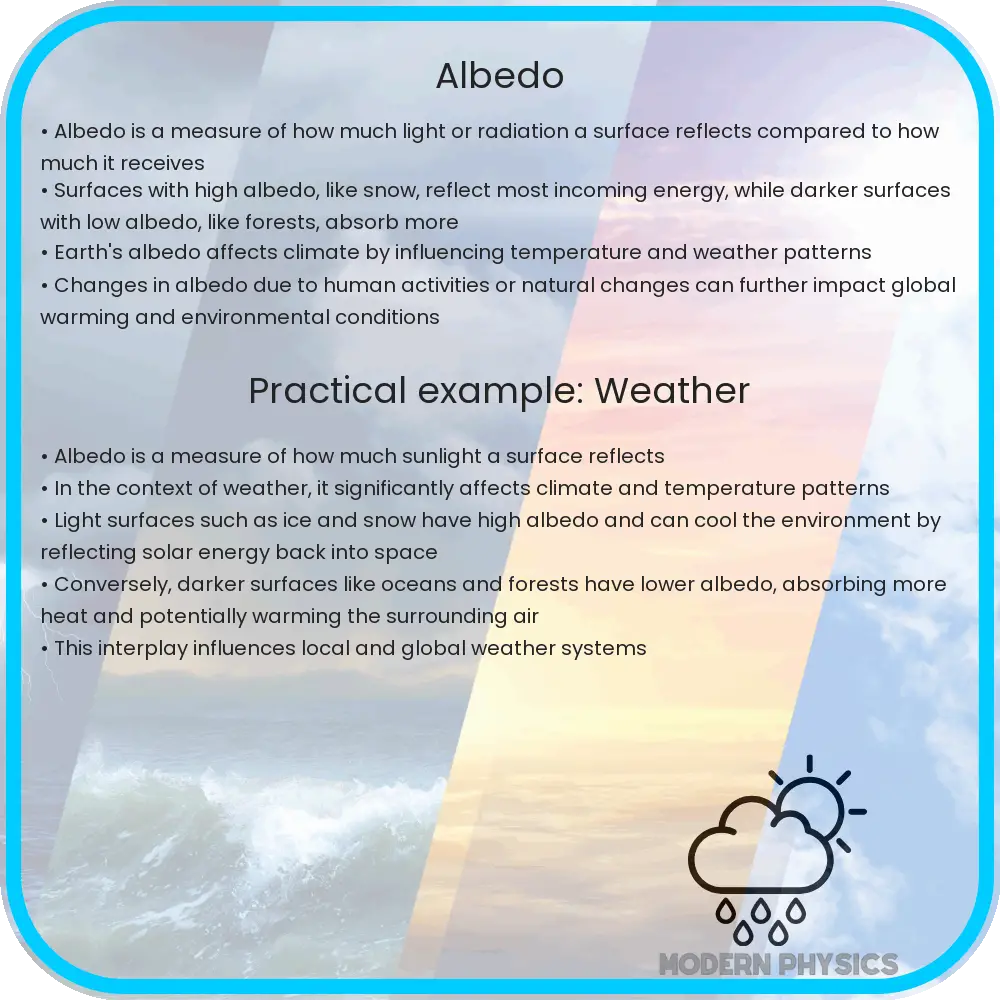Learn about albedo, the measure of how much solar energy Earth reflects back into space, and its crucial role in climate regulation.

Understanding Albedo and Its Impact on Climate
Albedo is a critical concept in the study of Earth’s climate system, referring to the fraction of solar energy (shortwave radiation) that is reflected from the Earth back into space. It is a dimensionless number that varies between 0 and 1. A higher albedo means more reflection and less absorption of solar energy, which can influence the local and global climate significantly.
The Earth’s albedo varies due to several factors including surface type, vegetation, and geographical location. For instance, snow-covered areas have a high albedo compared to forests or oceans. Understanding albedo helps in assessing Earth’s energy balance and is crucial for studying climate changes and global warming.
How Albedo Affects Climate
Albedo influences the Earth’s temperature by affecting the overall energy balance of the planet. When solar radiation hits the Earth, some of it is reflected back into space while the rest is absorbed. The fraction that is absorbed contributes to heating the planet. Thus, changes in albedo affect this balance dramatically.
Areas with higher albedo, like ice caps and glaciers, help cool the Earth by reflecting a significant amount of sunlight. Conversely, darker surfaces such as oceans or forests have a lower albedo, absorbing more heat and contributing to warming. As global temperatures rise and ice melts, the Earth loses albedo, which exacerbates the warming in a feedback loop, known as the ice-albedo feedback.
Measuring Albedo
Albedo is measured using various methods ranging from satellite observations to ground-based measurements. Satellites equipped with sensors and spectrometers are able to evaluate the radiation budget of the Earth and thus provide estimates of global albedo. Ground-based observations, while more localized, can provide detailed data on specific areas or surface types.
Scientists also use numerical values to express albedo, commonly referred to through different types of albedo such as surface albedo, which is directly related to the properties of the surface, and planetary albedo, which considers the entire Earth system, including clouds and atmospheric particles.
Reflection and Its Effects
The proportion of light that a surface reflects impacts not just its immediate environment but the global climate as well. Surfaces with high reflectivity can shield underlying areas from heat, thereby influencing weather patterns and local climate conditions. Moreover, the distribution of albedo across different geographical locations plays a role in the distribution of temperatures worldwide.
Reflection from surfaces like snow and ice not only cools the surface but can also affect atmospheric conditions above by altering temperature gradients. This change can influence wind patterns and precipitation, leading to complex climatic changes.
Exploring the concept of albedo and its implications on climate offers fascinating insights into how Earth maintains its energy balance and adapts to ongoing environmental changes. Tracking these measurements allows scientists to better predict climate trends and devise strategies for mitigating global warming.
Albedo Variability and Climate Change
Albedo is not a constant value and can vary according to seasonal changes and human activities. In regions with seasonal snowfall, albedo can fluctuate dramatically as snow covers and uncovers the ground throughout the year. Similarly, deforestation and urban development alter the landscape, significantly reducing the area’s albedo by replacing high-albedo surfaces like forests with lower-albedo surfaces like buildings and roads.
Understanding these changes is crucial for modeling climate predictions and assessing the potential impacts of different land use strategies on global warming. For example, planting more vegetation in urban areas can increase the local albedo and potentially reduce the urban heat island effect, a phenomenon where urban regions experience higher temperatures than their rural surroundings due to human activities.
Strategies to Modify Albedo
Given the significant role albedo plays in the Earth’s climate system, scientists and engineers are exploring ways to deliberately alter albedo as a method of geoengineering. One such proposal involves increasing the albedo of clouds by injecting sea salt into the atmosphere, which encourages the formation of brighter clouds that reflect more sunlight.
Another idea is to develop and deploy reflective materials in areas with low albedo, such as roofing materials in cities that reflect rather than absorb solar radiation. These strategies, while promising, must be approached with caution given their potential to disrupt local ecosystems and weather patterns.
Conclusion
The study of albedo encompasses a range of scientific disciplines and offers valuable insights into the dynamic relationship between Earth’s surface and its climate. By influencing how much solar energy is absorbed or reflected, albedo plays a pivotal role in regulating our planet’s temperature and climate patterns. As we continue to monitor and understand albedo variations, we unlock more opportunities to manage and mitigate the impacts of climate change.
Moving forward, integrating albedo research into climate resilience planning and considering albedo-enhancing technologies in our urban and rural development strategies can be transformative. With concerted effort and innovative approaches, altering the Earth’s albedo might become a viable tool in our endeavor to maintain ecological balance and counteract the warming trends creating challenging conditions worldwide.
Ultimately, embracing the complexities of albedo and its influence on climate is critical to our success in building a sustainable future. It invites us to look at the Earth not just as a collection of separate entities but as an interconnected system where every component plays a crucial role in shaping our environment.
